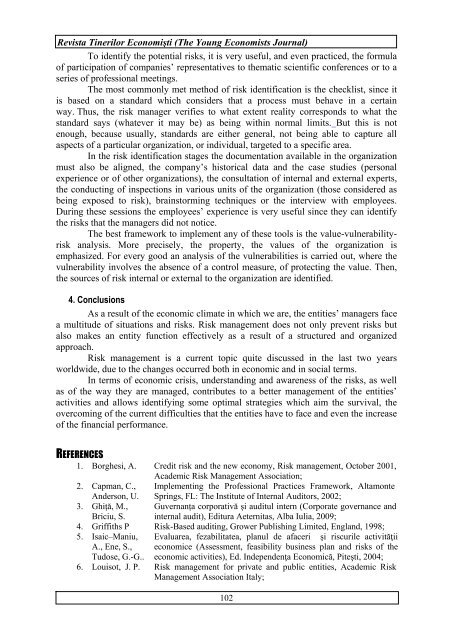Revista Tinerilor Economiºti (The Young Economists Journal)
Revista Tinerilor Economiºti (The Young Economists Journal)
Revista Tinerilor Economiºti (The Young Economists Journal)
You also want an ePaper? Increase the reach of your titles
YUMPU automatically turns print PDFs into web optimized ePapers that Google loves.
<strong>Revista</strong> <strong>Tinerilor</strong> Economişti (<strong>The</strong> <strong>Young</strong> <strong>Economists</strong> <strong>Journal</strong>)<br />
To identify the potential risks, it is very useful, and even practiced, the formula<br />
of participation of companies’ representatives to thematic scientific conferences or to a<br />
series of professional meetings.<br />
<strong>The</strong> most commonly met method of risk identification is the checklist, since it<br />
is based on a standard which considers that a process must behave in a certain<br />
way. Thus, the risk manager verifies to what extent reality corresponds to what the<br />
standard says (whatever it may be) as being within normal limits. But this is not<br />
enough, because usually, standards are either general, not being able to capture all<br />
aspects of a particular organization, or individual, targeted to a specific area.<br />
In the risk identification stages the documentation available in the organization<br />
must also be aligned, the company’s historical data and the case studies (personal<br />
experience or of other organizations), the consultation of internal and external experts,<br />
the conducting of inspections in various units of the organization (those considered as<br />
being exposed to risk), brainstorming techniques or the interview with employees.<br />
During these sessions the employees’ experience is very useful since they can identify<br />
the risks that the managers did not notice.<br />
<strong>The</strong> best framework to implement any of these tools is the value-vulnerabilityrisk<br />
analysis. More precisely, the property, the values of the organization is<br />
emphasized. For every good an analysis of the vulnerabilities is carried out, where the<br />
vulnerability involves the absence of a control measure, of protecting the value. <strong>The</strong>n,<br />
the sources of risk internal or external to the organization are identified.<br />
4. Conclusions<br />
As a result of the economic climate in which we are, the entities’ managers face<br />
a multitude of situations and risks. Risk management does not only prevent risks but<br />
also makes an entity function effectively as a result of a structured and organized<br />
approach.<br />
Risk management is a current topic quite discussed in the last two years<br />
worldwide, due to the changes occurred both in economic and in social terms.<br />
In terms of economic crisis, understanding and awareness of the risks, as well<br />
as of the way they are managed, contributes to a better management of the entities’<br />
activities and allows identifying some optimal strategies which aim the survival, the<br />
overcoming of the current difficulties that the entities have to face and even the increase<br />
of the financial performance.<br />
REFERENCES<br />
1. Borghesi, A. Credit risk and the new economy, Risk management, October 2001,<br />
Academic Risk Management Association;<br />
2. Capman, C., Implementing the Professional Practices Framework, Altamonte<br />
Anderson, U. Springs, FL: <strong>The</strong> Institute of Internal Auditors, 2002;<br />
3. Ghiță, M., Guvernanța corporativă și auditul intern (Corporate governance and<br />
Briciu, S. internal audit), Editura Aeternitas, Alba Iulia, 2009;<br />
4. Griffiths P Risk-Based auditing, Grower Publishing Limited, England, 1998;<br />
5. Isaic–Maniu, Evaluarea, fezabilitatea, planul de afaceri şi riscurile activităţii<br />
A., Ene, S., economice (Assessment, feasibility business plan and risks of the<br />
Tudose, G.-G.. economic activities), Ed. Independenţa Economică, Piteşti, 2004;<br />
6. Louisot, J. P. Risk management for private and public entities, Academic Risk<br />
Management Association Italy;<br />
102















